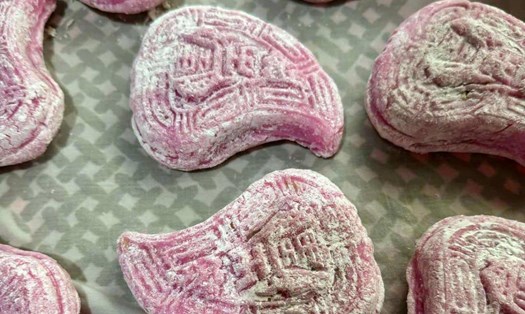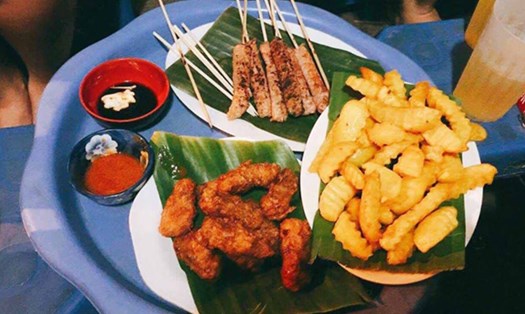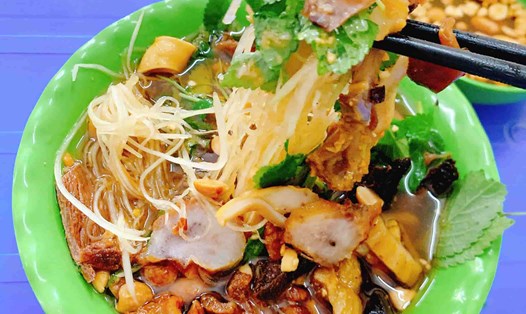100 year old apricot brand
Hang Duong has long been famous as a street specializing in selling dried fruit, with dozens of shops and brands, large and small, existing for generations. Among them, Toan Thinh dried fruit is one of the familiar addresses for many diners from near and far, and has just turned 100 years old.
Mr. Le Luong Ngoc (50 years old, Hanoi) is the fourth generation successor of the traditional dried fruit brand. For him, the jars of dried fruit are associated with childhood memories with his respected grandmother.
“I still remember before 1986, every fruit season, my grandmother bought ingredients and processed dried apricots little by little for the family to use. I sat next to her, feeling the meticulousness and meticulousness in each step of the original Hanoi woman. When I was 10 years old, my father, uncles and aunts were the third generation to make dried apricots and candies in the family, at that time they called in more old workers to rebuild the workshop. At that time, we reopened the Toan Thinh dried apricot and candies shop.”
While studying and helping his family produce and sell goods, for 6 years, Ngoc, his father and family worked hard at the candy and dried fruit factory, every day. At the age of 16, he temporarily stopped working to pursue his passion for studying architecture.
“When the store first reopened, it was very crowded. During the Mid-Autumn Festival or Tet, customers had to queue up to get stamps to buy goods like during the subsidy period. It wasn’t until 2010-2012 that the number of customers gradually decreased. I think it was because the way of doing business, taste and market had changed,” Ngoc said.
After 30 years of studying and building his own career, Mr. Ngoc became a famous architect in the industry with many outstanding achievements. In 2018 - 2019, when the previous generation was over 80 years old, he decided to return to continue the family business, combining nurturing his passion with preserving and promoting the traditional craft of making dried fruit.
When it comes to Toan Thinh dried fruit, in addition to the familiar dried fruit lines such as dried apricot, plum, apricot, star fruit..., the store also has special dried fruit lines with herbal flavors that increase medicinal properties, are good for health, and are favored by customers. In particular, the dried fruit here is processed according to a traditional recipe, by skilled workers, so that the spices penetrate deep into each dried fruit, making users suck on it for half a day without losing the taste.
Ngoc shared: “In essence, dried apricot is a medicinal herb, used by ancient people to treat diseases. Over time, following the natural market, people gradually forgot its true value, turning dried apricot into a simple daily snack, especially during holidays and Tet.
As a descendant in the family who understands that, I think I have the responsibility to restore and spread the core values of dried fruit, so that customers have a correct perception of this typical traditional product line."
After many years, the viewpoint of traditional dried fruit makers is to preserve the original flavor with manual processing, despite some limitations such as high cost, low productivity, short preservation time... Mr. Ngoc believes that if he wants to restore and develop the traditional dried fruit making profession, the current vital issue is raw materials and standardization of formulas.
He said: “When I was a child, I often went with my grandmother to the apricot region of Chua Huong, to Son La, Bac Can... to find raw materials. At that time, dried apricots were made from natural fruits in the forest, not fruits grown in the garden.
Nowadays, due to low economic efficiency, people often replace apricot and plum trees... to grow other trees. Huong Pagoda has almost no apricot trees left. For example, my family had to go all the way to Bac Kan and Son La to order from the locals to get the raw materials.
In addition to the desire to build and develop his own raw material area, Mr. Ngoc also has in mind the construction of a solid factory, standardizing all formulas to lay the foundation for the next generations. From there, the next generations can both preserve the traditional core and innovate properly based on what their ancestors left behind.

The "tasteful" way of enjoying food of the old Hanoians
Not only wanting to preserve and develop his family’s traditional craft of making dried fruit, Mr. Ngoc also wants to restore the space of memories, thereby introducing to today’s youth the elegant hobby, the way to enjoy tea, cakes, and dried fruit “with taste” of the ancient Hanoians. He believes that it is a very unique cultural beauty of the land of a thousand years of civilization.
Like the dried fruit brand that has been crystallized and developed for 100 years, the house at 15 Hang Duong also has a very special history.
Ngoc said: “In the past, Hang Duong street was a riverbed. I was born in an old house. In 1997-1998, when I was an adult, I decided to rebuild this house and realized that my ancestors had built 6 different houses before. That year's house was the 7th, and now it is the 8th.
Over time, I have noticed that life, society and everything have changed, but not completely disappeared. Unlike new buildings that can be demolished and rebuilt when needed, the beauty of an old townhouse is that it is built on, with things that have existed for hundreds of years, such as the backyard or the brick wall that lasts forever...”.
As an architect, Mr. Ngoc came up with the idea of building a house based on the old house foundation. In addition to the outside space displaying and selling Toan Thinh candies and sweets, inside the house there is also a space dedicated to enjoying tea and eating candied fruit, a small exhibition room about the brand’s history, a workshop area introducing the product making process, and a special tea and coffee shop on the roof.
With a house that can be used as a dining room, a place to rest at noon, and a living room for the owner, Mr. Ngoc diligently introduces to visitors the history, processing methods, and uses of the dried apricots, which are thought to be for fun but are actually precious medicinal herbs. Here, visitors also learn more about how to eat dried apricots properly, and what kind of tea or cake to drink with them to get the best flavor.
Mr. Ngoc said that his ancestors were very meticulous in enjoying tea and other snacks to ensure the right taste. To restore the intact traditional tea and cake table of Hanoi people, he traveled to many ceramic kilns to research and study.
He found a craftsman who could create a special type of blue-glossy sticky rice porcelain made from natural materials, helping the color of tea, cakes, and dried fruits to be at their most beautiful when combined on the table.
To convince the craftsman to continue producing this type of porcelain that requires a lot of effort and skill to make, Mr. Ngoc agreed to offer a high price and place orders. He believes that a delicious, unique dish when it reaches the customer not only needs to have quality and a distinctive flavor, but also needs to convey the cultural beauty and story value hidden in each product that makes it.
Looking ahead, the family's successor still has many concerns about developing the brand, creating economic profits while still maintaining the core values of traditional dried apricots, finding quality raw material areas... But above all, Mr. Ngoc still hopes to build a solid foundation, to bring the story of dried apricots as well as the wonderful uses of this special gift closer to the public, while creating opportunities to preserve and develop the traditional dried apricot making profession for future generations.




